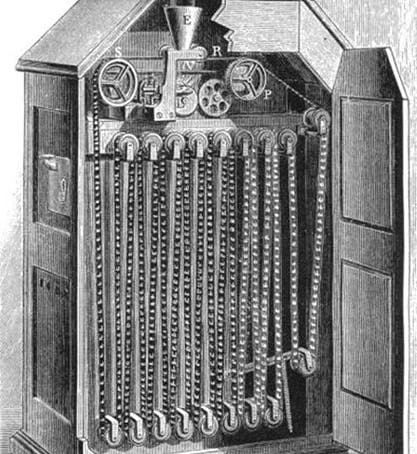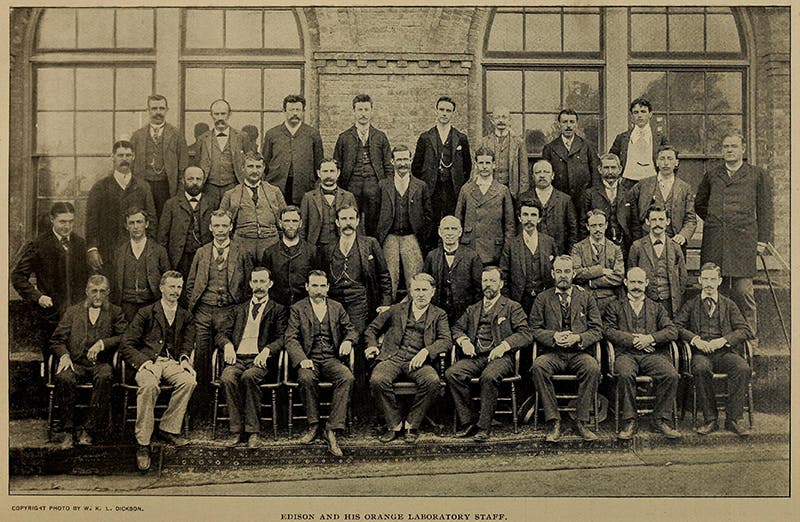Scientist of the Day - William Dickson
William Kennedy Laurie Dickson, a Scottish inventor who moved to the United States in 1879, was born Aug. 3, 1860. Through sheer persistence, he talked his way onto the staff of one of Thomas Edison's labs in New York City, where he began work in 1883, assigned to electrification problems (see portrait of a young Dickson). He must have been smart or savvy or both, because he rose rapidly through the ranks, and when Edison conceived the idea of a "Kinetoscope" or motion picture viewer in 1888 and filed a preliminary to a patent, he turned the task of actually designing and building such a machine over to Dickson. By 1891, Dickson and his staff had a working Kinetoscope. It did not project an image, but was rather a peep-hole machine, with tiny images on a thin loop of celluloid film that were illuminated by an Edison lamp (first image). The film was advanced at a constant speed by a motor, but a rotating shutter was designed to cut off the light between frames. The viewer looked down through an eyepiece on the top to see the projection. The illusion of a "moving picture" was convincing, or so everyone said.
Dickson cut his own film strips from sheets of celluloid. To expose them, Dickson and the lab team invented the Kinetograph, a motion picture camera. Unlike the Kinetoscope, the Kinetograph had a special mechanism that advanced the film intermittently to produce a rapid sequence of exposures. The film had perforations that were engaged by a gear mechanism; initially the perforations were on one edge only, soon the film was perforated on both sides. The film was 35 mm, and the format was 4 to 3. This is essentially the same mechanism, size, and format that was used on film cameras and projectors for the next hundred years and beyond.
To produce films, Edison set up a photographic studio in New Jersey called Black Maria. The top could open to admit sunlight for photography and close for developing, and the whole thing was mounted on a circular track to follow the sun. The photograph of the Kinetograph linked to above was taken inside Black Maria. You can see what is presumably a replica of Black Maria, but might be the original, at the Thomas Edison National Historical Park in West Orange, New Jersey. Just below is a photograph of Edison and his Orange Lab staff. Edison is front and center; Dickson is third from the right in the second row. Dickson also took the photo, so he was rather nimble as well.
Some 32 of Dickson's early films are preserved at the Library of Congress and are available online. The very first, called Dickson Greeting (1891), lasts all of 3 seconds; here it has been looped 9 times, so it will take 27 seconds of your time.
Dickson left Edison's Lab in 1895 to work for a firm that owned Kinetoscope emporia, then he returned to England and worked for a competing company that manufactured something called a Mutoscope, which was cheaper than a Kinetoscope. And then in 1911, for reasons we do not know, Dickson retired and virtually disappeared, both from public presence and the historical record, although he lived until 1935. Up through the 1960s, histories of motion pictures did not even mention Dickson, and full credit was given to Edison for inventing “The Movies.” More diligent historians have now established that both the Kinetoscope and the Kinetograph were essentially invented by Dickson; Edison provided full support to Dickson, but the inventions were not his.
Evidence of Dickson's rehabilitation is provided by the commemorative U.S. postage stamp series, Pioneers of Communication, issued in 1996. The stamp honoring "motion pictures" features Dickson, not Edison. The other three stamps honor Frederic Ives (inventor of the half-tone process), Ottmar Mergenthaler (inventor of the Linotype), and Eadweard Muybridge (photography pioneer). As you can tell by the links, we have honored each of these in previous posts, so with Dickson today, we have completed the Pioneers of Communication quadfecta.
Dr. William B. Ashworth, Jr., Consultant for the History of Science, Linda Hall Library and Associate Professor emeritus, Department of History, University of Missouri-Kansas City. Comments or corrections are welcome; please direct to ashworthw@umkc.edu.





![Using an astrolabe to measure the depth of a well, woodcut in Elucidatio fabricae vsusq[ue] astrolabii, by Johannes Stöffler, 1513 (Linda Hall Library)](https://assets-us-01.kc-usercontent.com:443/9dd25524-761a-000d-d79f-86a5086d4774/a998eb50-55d2-4a88-ace2-a50aa5fa86e7/Stoffler%201.jpg?w=210&h=210&auto=format&fit=crop)

